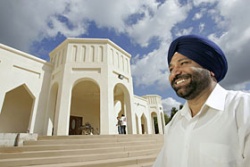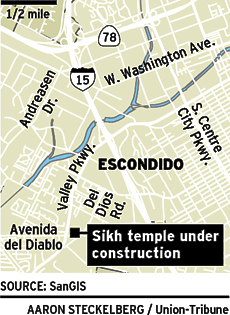New Gurdwara in San Diego: Difference between revisions
Hari singh (talk | contribs) (New page: {{p|Image:San Diego Sikh.jpg|Sikh Society President Amritpal Singh Takhar stood in front of the new Sikh temple in Escondido last week. Domes painted gold will be placed above the main ent...) |
Hari singh (talk | contribs) No edit summary |
||
| Line 7: | Line 7: | ||
It has taken the Sikh Society of San Diego 15 years to build this $1.5 million gurdwara. | It has taken the Sikh Society of San Diego 15 years to build this $1.5 million gurdwara. | ||
When services begin, tentatively on Dec. 7, it will become the second of just two Sikh temples to serve 500 families from Riverside to Chula Vista. Of those, 150 families will attend the Escondido temple. The rest go to a temple in Poway or elsewhere. | When services begin, tentatively on Dec. 7, it will become the second of just two Sikh temples to serve 500 families from Riverside to Chula Vista. Of those, 150 families will attend the {{w|Escondido}} temple. The rest go to a temple in Poway or elsewhere. | ||
''“This is a very important moment for us. We wanted to build this for our kids, the next generation, so they have a place to worship,”'' said Baljit Singh Toor, chairman of the Sikh Society. | ''“This is a very important moment for us. We wanted to build this for our kids, the next generation, so they have a place to worship,”'' said Baljit Singh Toor, chairman of the Sikh Society. | ||
Revision as of 18:08, 9 November 2008

photo: CHARLIE NEUMAN / Union-Tribune
A temple for the next generation - After 15 years, Sikh Society to open hall, thanks to contributions from its members. Article by Angela Lau, UNION-TRIBUNE STAFF WRITER. November 9, 2008
At Valley Parkway and Avenida del Diablo, a striking, light yellow, Eastern-looking temple is almost ready for its first service.
It has taken the Sikh Society of San Diego 15 years to build this $1.5 million gurdwara.
When services begin, tentatively on Dec. 7, it will become the second of just two Sikh temples to serve 500 families from Riverside to Chula Vista. Of those, 150 families will attend the Escondido temple. The rest go to a temple in Poway or elsewhere.
“This is a very important moment for us. We wanted to build this for our kids, the next generation, so they have a place to worship,” said Baljit Singh Toor, chairman of the Sikh Society.
Services are currently held at Del Dios Middle School twice a month on Sundays, although Sikhs pray more often than that – daily at sunrise and sunset.
“It is not convenient. We want a place where people can walk in anytime and pray,” Toor said.
Sikhs (sikh means seeker of truth) practice Sikhism, a minority religion in India founded by Guru Nanak about 500 years ago in the Punjab area, in the northern and eastern regions of India. Today, an estimated 20 million people practice the religion worldwide.
Sikhism worships one God without human form, and it teaches followers to merge with God through religious devotion, meditation and service, and to live in peace and with integrity. Sikhs reject the use of idols and statues as well as the caste system.
That's why the walls of the Escondido temple will not have paintings of humans or deities.
Sikhs revere a holy book called the “Dasam Granth,” a 1,430-page Sanskrit tome that will be placed in the middle of the worship hall. During services, it will be read by volunteers or a priest, if the Sikhs hire one from India.
Another distinguishing characteristic of Sikhism is the full equality of women. In the temple, men and women enter together and sit in the same hall, although on different sides, as custom dictates. Both genders can read the holy scriptures during service.
Years in the making
At Avenida del Diablo, the Sikhs' dream began in 1993 when they bought the 1.29 acres for $125,000, Toor recalled.
HIGHLIGHTS
- Sikh Society of San Diego Temple Location: 1838 Avenida Del Diablo, Escondido.
- Size: Phase I is a 6,000-square-foot worship hall with a kitchen. Phase II will add a Sunday school and dining room.
- Religion: Sikhism, an Indian religion founded about 500 years ago by Guru Nanak.
- Cost of temple: $1.5 million.
- Opening: Tentatively Dec. 7
The land was cheap, and Escondido seemed diverse enough to be religiously tolerant.
In 1994, the city approved a temple that would have looked like a house, said city associate planner Jay Paul.
But when the Sikhs realized how much they would have to spend to build it, they decided they'd rather have a temple that has the architectural flair of traditional temples – high ceilings, cavernous worship halls and signature gold domes.
But the redesigned structure, a replica of a Punjab temple, was rejected by the Planning Commission in 1998 on the basis that the architecture was incompatible with the neighborhood.
The Sikhs appealed to the City Council, which decided that the gold domes could stay, but the temple should be smaller.
“We have never rejected a church,” Mayor Lori Holt Pfeiler said.
The Sikhs reduced the size and agreed to use matte gold paint for the domes to ease concerns over the brightness of shiny gold domes.
In 2005, the foundation was poured. But the Sikhs quickly found that no bank would lend money to them because they had already started construction, Toor said.
That's when 17 members volunteered to each pay $5,100 every year and $101 a month to help maintain the temple. Sikhs like odd numbers because they believe if they give one, they will receive two in return.
Those 17 became members of the board of trustees.
Next, the Sikhs asked each child in the society to give up $100 of their spending money to finance the 25 fans needed for the worship hall and the dining area.
Last, they asked individuals to sponsor equipment. An Indian restaurant donated blinds for the kitchen. A family donated the carpet for the worship hall, and 13 families footed the bill for 13 parking lot lights.
Last week, Sikh Society leaders stood in the bright morning sun to savor the grandeur of the product of their collective efforts.
Sikh Society President Amritpal Singh Takhar was so proud he even showed off two ground-level sinks where worshippers wash their hands and feet before taking off their shoes to enter and worship.
Once inside, they cover their heads with turbans or handkerchiefs, and they sit on the floor cross-legged, with their soles pointing away from the holy book.
After each service, a free vegetarian meal is served.
“We feed the hungry. We never turn anyone away,” Toor said. “Anyone is welcome to our services and meals.”
December opening
If all goes according to plan, and the temple opens Dec. 7, it may seem a little naked without its three gold domes.
They have not been manufactured and will not be installed until six months later, as part of a second construction phase, which will include Sunday school and a dining area, Toor said.
The Sikh Society is negotiating with a manufacturer in Maryland that makes custom domes for Indian temples in the United States.
Instead of using the traditional concrete or marble, the Maryland dome-maker, Didar Singh Rehsi, a descendant of Indian dome manufacturers, uses fiberglass for ease of transport and to avoid crushing the wood-framed structure underneath.
The domes would be made in segments, sprayed with a long-lasting metallic gold paint, and transported by trucks to Escondido, where they would be installed with the help of a crane, he said.
They would be a far cry from the splendor of the beloved main temple in Punjab, the Golden Temple, so-called because it is covered with gold from top to bottom.
But the half-spheres will do, Toor said. The large one will be in the center, measuring 16 feet high – including a 5-foot spire – and 12 feet wide.
It will be flanked by two smaller domes measuring 12 feet high – including a 4-foot spire – and 8 feet wide.
It's been a long and difficult road, Toor said, but they will not rest until everything is in place.
“This is a community effort. Everyone pitches in,” he said. “We don't put any names on anything because we wanted this temple, so we contributed and volunteered.”

